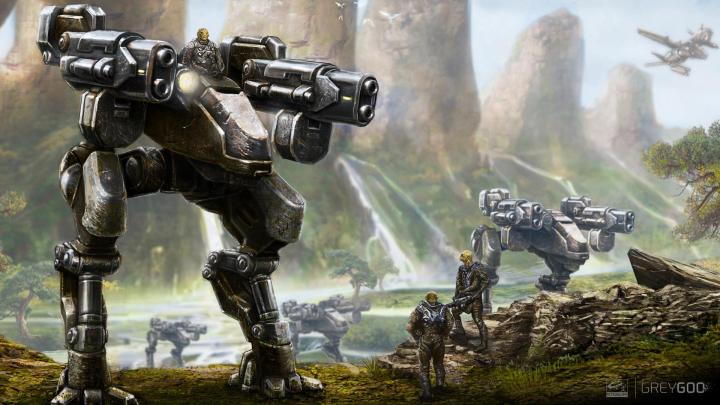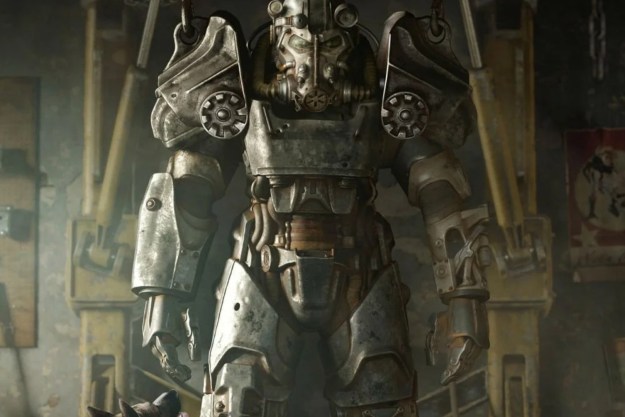
We’ve come a long way since the days of Command & Conquer, but the team at Petroglyph Games – founded by C&C’s creators, no big deal – would like to get back to that. Maybe with just a little less live-action cheese, a little more aliens-are-coming sci-fi action.
Enter Grey Goo, the freshly announced real-time strategy game from Petroglyph, Grey Box, and Weta Workshop that pits three asymmetrically balanced factions against one another on campaign-driven and multiplayer battlefields. It’s early days yet for the new IP, the idea for which was hatched by Grey Box, but one look at the game’s bird’s-eye view vistas confirms that this is an old-style RTS with a shiny wrapper (and some nifty ideas, as you’ll soon see) laid on top of it.
Story/Concept

We are pretty much alone. Grey Goo‘s story is set in the distant future of the human race, long after we’ve mastered the challenges of intragalactic space travel. For all of the alien fiction and widely held beliefs that there’s other life out there in the universe, it turns out that the human race has pretty much got space all to itself. Extensive exploration turned up nine life-supporting planets, with nothing even close to intelligent life found on any of them.
Or so we thought. That last planet discovered by humans, Ecosystem 9, actually does house an alien life form, the Betas. They’re visitors too, and they’ve decided to establish a settlement on the planet. The humans eventually discover this, and the story explores what happens in the aftermath of that discovery. Presumably, there’s lots of violence. The game’s titular third faction, the Grey Goo, comes in at some point, but it’s not clear how yet. In its current form, the campaign spreads out over 15 missions, split evenly among the factions: first with the Betas, then with the humans, and finally with the unusual Goo.
Gameplay

Old-time strategy. The gameplay in Grey Goo is fairly traditional RTS. You build and manage bases and armies from a top-down view, with the goal being to meet every offense with a defense that capitalizes on the attackers’ weaknesses, and poke holes in every defense with an adaptable offense. The game’s basic systems and user interface are immediately familiar. We didn’t get a chance to play the game, but it looks the part of an admittedly slick-yet-traditional RTS.
It’s hard to speak with any kind of authority to the specifics since we haven’t actually played the game yet, but the action seems to flow around gathering resources that you convert to energy and use to build an army, which you then send out to squash the enemy. Straightforward stuff. There are land units and air units, mobile defenses and fixed emplacements, and late-battle epic units. Each faction requires a very different approach, but the parts that make them up are all familiar.
The human condition. Grey Goo‘s human faction is built around the idea of fortress-building, or “turtling” for you RTS vets. First you establish a base around a main power core in a central location. That base doesn’t move, but the humans have speedy units for gathering resources from distant locations. They’ve also got teleportation technology for quickly moving armies around the map.
All components of a human base, from production-focused Factories and Airfields (which both build units) to upgrade-unlocking Tech Facilities must either be connected to the main power core directly or linked to it via power conduits. The centralized nature of the faction’s base-building means you’ll need to rely heavily on point defenses, like turrets, and walls, which can be fortified with individual units. You don’t fight to claim territory as the human faction; instead, you shore up your foundation around a giant army that you then teleport in to completely decimate your opponents.

The Beta bands. The Betas are a direct contrast to the humans in that they’re made to be mobile. This faction doesn’t rely heavily on a single, central bases. The Beta faction can build multiple power hubs of varying sizes. Each hub has two, four, or six nodes (depending on the size you build), to which support facilities – Factories, Airfields, Refineries, and Tech Facilities – can be attached. Each facility functions much like it does for the humans, though Beta refineries come with slower resource collectors, which serves as a balance against the faction’s more willy-nilly approach to base-building.
The Betas can build walls and point defenses, much like the humans can, but it’s important to remember that their chief advantage is an ability to spread out and conquer territory. A Beta base can be constructed virtually anywhere, and a smart player will slowly spread his or her reach across the entire map. They may not be able to teleport like the humans can, but a capably deployed Beta army with factory hubs in the right places can stream in on a target endlessly from every direction imaginable.
Going goo. The Grey Goo is… different. In truth, it’s like nothing we’ve seen before in an RTS. The “faction” is built around the idea of a giant “Mother Goo” blob that is completely mobile. Hills, mountains, even enemy walls aren’t a problem for the Goo. It simply oozes along, consuming any resource nodes, enemy units, or structures it engulfs. The Mother Goo grows in size as it absorbs more matter, eventually getting large enough that you can split off more Mother Goos.

The Grey Goo faction doesn’t build a base or any kind of structures in the traditional sense. All resource gathering and unit production is relegated to the Mother Goo(s), which also serves as a potent – if low-health – offensive unit on its own. There is no base in the traditional sense. The Mother Goo grows as it absorbs resources, then splits itself to form new Goo blobs or “spends” itself on constructing more typical RTS units, like tanks and infantry. Multiple Goo blobs can reconstitute into a larger Goo, but all other units count as “spent” resources; they keep going until they’re destroyed, but they’re forever removed from the space blob that created them.
All of these elements promise to shake up the gameplay significantly. Suddenly you’ve got a faction that can simply ooze into your territory and start causing damage – not to mention spitting out units it creates on the spot – regardless of any defenses you might have built to hinder enemy advances. You’ve got to rethink your approach to building an army if you’re going to play as the Goo, but you’ve got a lot of added flexibility when the time comes to mount an attack.
Presentation

Retro eye candy. There’s an old school flavor to the top-down view and hotkey-based command bar at the bottom of the screen, but the textures and visual effects are clearly the product of skilled creators. There’s a lot of detail in the individual textures, especially evident when you see the function-over-form-favoring Beta’s spider-like constructors piecing together a base. Everything on the screen pops, from the individual units to the intricate terrain.
Takeaway
Grey Goo appears to be shaping up as a fresh take on a classic genre. The asymmetrical design of the three factions carries a lot of strategic promise, especially once you get a sense of how the wildly different Goo faction is meant to be played. Petroglyph and Grey Box see the game as a Steam-based PC exclusive, with plans to include a terrain editor and support for LAN play at launch. They want to stress that this is not a free-to-play creation, but iterative, community-supported development a la Steam Early Access is a distinct possibility.


